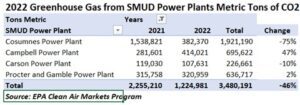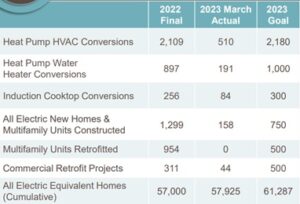Author: Rick Codina
Current and Projected Greenhouse Gas (GHG) Emissions
Of course, the immediate emission results have been disappointing the last two years, owing to the recently ended drought and poor availability of hydro resources, as well as the disabled Cosumnes generator which forced SMUD to rely heavily on its less-efficient thermal plants, as well as the Calpine Sutter Energy contract and market purchases from the Western States Power Pool.
The ZCP slide presentation update sidesteps any discussion of actual greenhouse gas emissions in the immediate or long term. However, this omission is made up in the ZCP Report itself which also candidly notes that SMUD can expect no better than meeting historical GHG emissions until 2026. This admission is a welcome point of transparency.
Recommendations:
- At the least, the Zero Carbon update presentations should include one or more slides showing the most recent emission tally and how the planned future resources will step down these totals to carbon zero in 2030.
- I am pleased to learn that SMUD will soon release a public dashboard which will provide timely updates on metrics, including GHG. I look forward to this highly important new development in public transparency.
Retirement For Campbell and McClellan
Last year’s Plan Update identified the 2024-25 time frame for the shutdown of the McClellan and Campbell power plants. In this Plan Update, we now see that the closure of these plants has been delayed to 2026. In fact, in the last year rather than beginning to phase down, Campbell increased operation by nearly 50% as the disabled Cosumnes plant reduced its operation by 75% (see chart).
Recommendation:
- We understand the uncertainty of some replacement renewable projects, but we urge staff to work towards ramping down and if possible retiring Campbell and McClellan earlier than scheduled. These two plants are the least efficient in SMUD’s fleet and are also located in urban areas with environmental justice air quality impacts.
Other Gas-Fired Resources
I will not comment here on the recent and somewhat contentious proposal to contract power from a future Calpine Sutter carbon storage and sequestration (CCS) project to be discussed and voted upon next month. But the Update does include the CCS project in an entire slide, and as a prospective placeholder in its resource mix. This raises the possibility of employing CCS to meet the carbon zero target early by 2027. It also poses questions on how a CCS contract would affect the planned re-tooling of SMUD’s residual gas-fired power plants.
- Procter and Gamble and Carson Ice. The Plan continues to call for conversion of Procter and Gamble (2029) and Carson Ice (2027) to peaking plants. Will this be affected by the addition of the CCS baseload source of reliability? And, in particular, how will the GHG balance of emissions be affected if Procter must substitute natural gas for SMUD steam?
- Cosumnes. The Plan also continues to call for Cosumnes to ramp down its operation until 2030, as a combined cycle plant that will provide flexible support for back-up and regulation. Would the CCS speed up its transition to an alternate fuel, perhaps hydrogen. And what will become of the SMUD biogas from Regional Sanitation and other sources currently being piped to Cosumnes?
Utility Renewable Projects
On the one hand, the Update reports the good news that the Calpine geothermal and Solano Wind Energy upgrade will be on-line by year’s end. On the other hand, it reports that the local solar projects will be delayed by a year. More so, we know that the Coyote Creek Agrivoltaic’ s success is not certain with the EIR still unreleased, and numerous environmental groups in opposition. The Plan does show several future prospective solar contracts and it identifies an unspecified 190 MW of local solar starting in 2025. Given environmental sensitivities, any new local renewable source under consideration should be publicly identified at an early stage.
Recommendations:
- SMUD should provide more information on the proposed local 190 MW solar project.
- As it did with the Feed-In Tariff contract solicitation more than a decade ago, SMUD should identify local solar sites which meet its environmental and distribution system criteria. It should then actively seek proposals for projects in the identified areas.
Storage Projects
The Plan identifies the long-duration flow batteries being tested this year and the next, which presumably will lead to larger-scale deployment in 2025-26. But it fails to mention the potential pumped hydro at Jones Fork and Union Valley mentioned last year.
On the customer side, the Report provides a line-item to recognize solar and battery contribution from customer installations, something omitted last year. It also mentions the battery dispatch program, My Energy Optomizer Partner, which will launch this summer and is limited to home installations with a Tesla Power Wall. It also reports the investigation of community solar projects for schools and non-profits.
Recommendations:
- Clarify whether the pumped hydro project is still under consideration.
- Consider expanding the My Optimizer Partner+ battery dispatch program to larger commercial customers with existing solar installations such as the County airport.
- Expand the scope for a pilot study for Community Solar and Battery projects beyond schools and non-profits to include municipal entities.
- Evaluate large-scale thermal cooling storage at new commercial and industrial sites, or even at existing facilities such as data centers which require 24-hour cooling.
Building Electrification Projects
SMUD continues to show its commitment to building electrification with generous targeted electric equipment incentives and technical support electrification ordinances and other actions with the city, county, and air quality management district. We are also pleased with the new Community Impact Plan, which recently provided efficiency and electrification upgrades in the Gardenland community, and the plans for a zero interest loan program.
However, the Plan’s first quarter report for 2023 shows relatively anemic electrification results, particularly the total lack of year-to-date multi-family conversions. The program also appears to use apparently arbitrary goals that are at odds with actual equipment turnover, which may be as much as 6 times higher.
Recommendations:
- Expand the Community Impact plan to actively engage with local agencies such as CADA and SHRA as well as low-income weatherization groups such as the Community Resource Project to identify low-income and other multi-family complexes that can be converted to heat pumps and other electrification equipment.
- Set higher electrification goals aimed at a much-higher capture rate of equipment at burnout.
- Leverage SMUD incentives with other state and federal funds to help launch pilot demonstration of emerging new technologies including 120-volt heat pump water heaters and window heat pumps such as the unit being employed in NYC housing projects.






